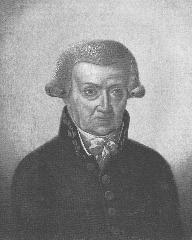 Johann Christoph Brotze (1742 – 1823) was
born in Gerlitz, studied theology and philosophy at universities
of Leipzig and Wittenberg, he also mastered technical drawing. In
1768 Brotze moved to Riga where he worked as a tutor and since
1769 he has started to teach at Riga Lyceum where he has worked
for 46 years. Brotze belonged to the trend of late humanism,
so-called school of erudites. He considered collecting and
processing of historical sources as his main task. Brotze
collected historical materials and drew everything that seemed
significant to him: people, buildings, coins, armorial bearings,
plans of towns, technical innovations, etc., fixing everything
with great preciseness and always adding written explanations
which could sometimes contain just a couple of lines and
sometimes occupied several pages. Many of the objects and
documents drawn by him had perished or disappeared in the course
of time, but information about them has been preserved only in
Brotze’s drawings and descriptions which are summed up in his
most significant work “Sammlung verschiedner Liefländischer
Monumente ...”
Johann Christoph Brotze (1742 – 1823) was
born in Gerlitz, studied theology and philosophy at universities
of Leipzig and Wittenberg, he also mastered technical drawing. In
1768 Brotze moved to Riga where he worked as a tutor and since
1769 he has started to teach at Riga Lyceum where he has worked
for 46 years. Brotze belonged to the trend of late humanism,
so-called school of erudites. He considered collecting and
processing of historical sources as his main task. Brotze
collected historical materials and drew everything that seemed
significant to him: people, buildings, coins, armorial bearings,
plans of towns, technical innovations, etc., fixing everything
with great preciseness and always adding written explanations
which could sometimes contain just a couple of lines and
sometimes occupied several pages. Many of the objects and
documents drawn by him had perished or disappeared in the course
of time, but information about them has been preserved only in
Brotze’s drawings and descriptions which are summed up in his
most significant work “Sammlung verschiedner Liefländischer
Monumente ...”
This collection contains 10 volumes
bound in leather (3246 pages; the page format is 33 x 21 cm).
Most of the pictures drawn by Brotze are originals, but there are
also plans and drawings made by other artists. A good deal of
Brotze’s original pictures are one-colour drawings in Indian
ink made with a pen. Coloured drawings are either water-colours
or pen-drawings toned with water-colours. Unfortunately, some of
the colours in these drawings of the 18th and 19th centuries have
turned pale by now, for example, bluish and yellowish tones of
the sky; in some cases just separate speckles remain.
In Brotze’s drawings and
descriptions there are armorial bearings of the Baltic nobles,
stamps and monuments of archbishops, bishops, towns, courts,
churches as well as inscriptions on gravestones, buildings,
bells, goblets and other things, views of Baltic estates,
castles, towns and settlements, public edifices, dwelling houses,
churches as well as topographic maps of separate places,
inhabitants of towns and countryside, their clothes, lifestyle
and profession and delineation of work process, different
technical equipment (water-supply, telegraph, etc.). Here we can
find information about many Latvian and Estonian towns. It was
characteristic for Brotze’s work style to collect as much
information about some town as possible. To show a town in
development, Brotze collected plans drawn in different years,
drew the most significant buildings of the town, and gave its
historical description and economic and administrative
characterization. He also gave information on inhabitants of the
town and their occupation.
 Johann Christoph Brotze (1742 – 1823) was
born in Gerlitz, studied theology and philosophy at universities
of Leipzig and Wittenberg, he also mastered technical drawing. In
1768 Brotze moved to Riga where he worked as a tutor and since
1769 he has started to teach at Riga Lyceum where he has worked
for 46 years. Brotze belonged to the trend of late humanism,
so-called school of erudites. He considered collecting and
processing of historical sources as his main task. Brotze
collected historical materials and drew everything that seemed
significant to him: people, buildings, coins, armorial bearings,
plans of towns, technical innovations, etc., fixing everything
with great preciseness and always adding written explanations
which could sometimes contain just a couple of lines and
sometimes occupied several pages. Many of the objects and
documents drawn by him had perished or disappeared in the course
of time, but information about them has been preserved only in
Brotze’s drawings and descriptions which are summed up in his
most significant work “Sammlung verschiedner Liefländischer
Monumente ...”
Johann Christoph Brotze (1742 – 1823) was
born in Gerlitz, studied theology and philosophy at universities
of Leipzig and Wittenberg, he also mastered technical drawing. In
1768 Brotze moved to Riga where he worked as a tutor and since
1769 he has started to teach at Riga Lyceum where he has worked
for 46 years. Brotze belonged to the trend of late humanism,
so-called school of erudites. He considered collecting and
processing of historical sources as his main task. Brotze
collected historical materials and drew everything that seemed
significant to him: people, buildings, coins, armorial bearings,
plans of towns, technical innovations, etc., fixing everything
with great preciseness and always adding written explanations
which could sometimes contain just a couple of lines and
sometimes occupied several pages. Many of the objects and
documents drawn by him had perished or disappeared in the course
of time, but information about them has been preserved only in
Brotze’s drawings and descriptions which are summed up in his
most significant work “Sammlung verschiedner Liefländischer
Monumente ...”